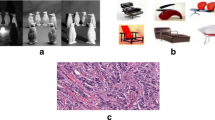Abstract
Most image segmentation algorithms optimize some mathematical similarity criterion derived from several low-level image features. One possible way of combining different types of features, e.g. color- and texture features on different scales and/or different orientations, is to simply stack all the individual measurements into one high-dimensional feature vector. Due to the nature of such stacked vectors, however, only very few components (e.g. those which are defined on a suitable scale) will carry information that is relevant for the actual segmentation task. We present an approach to combining segmentation and adaptive feature selection that overcomes this relevance determination problem. All free model parameters of this method are selected by a resampling-based stability analysis. Experiments demonstrate that the built-in feature selection mechanism leads to stable and meaningful partitions of the images.
Access this chapter
Tax calculation will be finalised at checkout
Purchases are for personal use only
Preview
Unable to display preview. Download preview PDF.
Similar content being viewed by others
References
Belongie, S., Carson, C., Greenspan, H., Malik, J.: Color- and texture-based image segmentation using the expectation-maximization algorithm and its application to content-based image retrieval. In: Int. Conf. Computer Vision (1998)
Ben-Dor, N.: Friedman, and Z. Yakhini. Class discovery in gene expression data. In: Procs. RECOMB, pp. 31–38 (2001)
Dempster, A.P., Laird, N.M., Rubin, D.B.: Maximum likelihood from incomplete data via the EM algorithm. J. R. Stat. Soc. B 39, 1–38 (1977)
Figueiredo, M., Jain, A.K.: Bayesian learning of sparse classifiers. In: CVPR 2001 (2001)
Hastie, T., Tibshirani, R.: Discriminant analysis by gaussian mixtures. J. R. Stat. Soc. B 58, 158–176 (1996)
Hastie, T., Tibshirani, R., Buja, A.: Flexible discriminant analysis by optimal scoring. J. Am. Stat. Assoc. 89, 1255–1270 (1994)
Kuhn, H.W.: The hungarian method for the assignment problem. Naval Res. Logist. Quart. 2, 83–97 (1955)
Lange, T., Braun, M., Roth, V., Buhmann, J.M.: Stability-based model selection. In: Advances in Neural Information Processing Systems, vol. 15 (2003)
Law, M.H., Jain, A.K., Figueiredo, M.A.T.: Feature selection in mixture-based clustering. In: Advances in Neural Information Processing Systems, vol. 15 (2003)
Manjunath, B.S., Ma, W.Y.: Texture features for browsing and retrieval of image data. IEEE Trans. Pattern Anal. Mach. Intell. 18(8), 837–842 (1996)
Osborne, M., Presnell, B., Turlach, B.: On the lasso and its dual. J. Comput. Graph. Stat. 9, 319–337 (2000)
Roth, V., Lange, T.: Feature selection in clustering problems. In: Advances in Neural Information Processing Systems, vol. 16, MIT Press, Cambridge (2004)
Roth, V., Lange, T.: Bayesian class discovery in microarray datasets. IEEE Trans. on Biomedical Engineering 51(5) (2004)
Tibshirani, R.J.: Regression shrinkage and selection via the lasso. JRSS B 58, 267–288 (1996)
Heydebreck, A.v., Huber, W., Poustka, A., Vingron, M.: Identifying splits with clear separation: a new class discovery method for gene expression data. Bioinformatics 17 (2001)
Author information
Authors and Affiliations
Editor information
Editors and Affiliations
Rights and permissions
Copyright information
© 2004 Springer-Verlag Berlin Heidelberg
About this paper
Cite this paper
Roth, V., Lange, T. (2004). Adaptive Feature Selection in Image Segmentation. In: Rasmussen, C.E., Bülthoff, H.H., Schölkopf, B., Giese, M.A. (eds) Pattern Recognition. DAGM 2004. Lecture Notes in Computer Science, vol 3175. Springer, Berlin, Heidelberg. https://doi.org/10.1007/978-3-540-28649-3_2
Download citation
DOI: https://doi.org/10.1007/978-3-540-28649-3_2
Publisher Name: Springer, Berlin, Heidelberg
Print ISBN: 978-3-540-22945-2
Online ISBN: 978-3-540-28649-3
eBook Packages: Springer Book Archive




